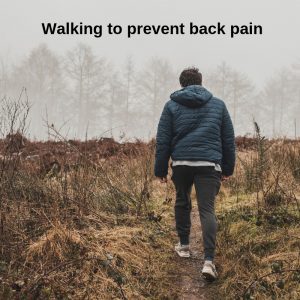Walking is probably the cheapest and most accessible form of exercise there is. Hippocrates called it “mans best medicine”. Find out below how you can use walking to prevent back pain.
In 2018 The British Journal of Sports Medicine published a special edition that looked specifically at the health benefits of walking to mark the 21st Anniversary of a really important paper called walk to health by Morris and Hardman. What this paper did 21 years ago was shifted the focus of health benefit away from just vigorous activity in the form of structured exercise regimes, but instead highlighted the fact that benefits can also be achieved through moderate activity such as walking. The 2018 special edition was a review and update on this research and it essentially highlighted further that walking is brilliant for health, is cheap and accessible. In the conclusion they say it represents a “best buy for public health”
Video on the health benefits of walking
There is research that exercise helps with back pain. But what about walking? Can walking help prevent or reduce back pain, and if so how much and how often?
A study published in the spine Journal in November 2018 tried to address this very question and looked at the association between weekly walking and low back pain. So what did they find?
Walking for more than 3 days per week for 30 minutes at a time was associated with a decrease in back pain. This increased further with more walking. People who walked for an hour on 5 days per week derived more benefit, ie less pain.
How can walking help with back pain?
Walking has been referred to as nature back balm. A balm is a something we rub onto something to lubricate it and is something that can be reapplied often. If you think of lip balm it is something that can be applied to dry lips often throughout the day. No such balm exists that can be rubbed into the back to lubricate it, however we do have the ability to apply lubrication to the joints through a simple activity that is natural and underutilised by many …. Walking.
When we walk we lift the leg and bring it forward and this requires us to use muscles in the legs, pelvis, back and arms. Each step produces a gentle muscle contraction that is repeated many times during walking. This gentle contaction helps to maintain muscle health by retaining strength as well as bringing blood to the muscles which transports along with it nutrients for the muscles, it also helps remove waste products that build up in the muscle.
Walking with a good arm swing and a quick pace is important as this trains muscular slings (connections between the arm/back/pelvis/leg muscles) that help to reduce and prevent back pain. Another thing that happens when we walk is we get movement through joints. This helps to release synovial fluid from the cartilage into the joints which lubricates the joints. Hence acting like a “balm”
What if walking aggravates your back pain?
Sometimes when our backs are very sensitive even walking can be painful. In these instances it might be appropriate to utilise some other strategies to decrease the sensitivity. However walking can still play an important part. Ensure you still walk around but do it little and often. If it hurts even after a minute of walking then walk for 45 seconds every half hour. As it becomes less sensitive you will be able to walk further and do it less often.
Will walking more slowly help until I can walk faster?
In short, no. Not really. When we walk slowly or stroll whilst shopping etc.. this can increase static load on certain structures in the spine which is not beneficial and can become sore. When walking slowly we also do not utilise an arm swing so we don’t get the benefit of muscular slings, and we sometimes lock out our knee which removes some of the bounce or sping in our step which is needed to make walking more effective.
How to walk in an effective way to help achieve reduction in back pain.
- Firstly stand up nice and tall in a good posture
- Begin walking and swing your arms from the shoulders not the elbows
- Progress to a faster, purposeful walk that “means business” Walk like you have somewhere to be
Building a pain free walking program.
As stated earlier if you have a high pain sensitivity you may need to utilise other strategies to reduce this before embarking on a walking program. However that does not mean you should avoid walking (even if it hurts) Move around and walk little and often.
Once you can start to walk for short periods without it increasing pain then you can begin to increase how much you walk. Our goal is to increase your “envelope of function” which we have spoke about earlier.
The rationale behind building a pain free walking program is to slowly and methodically increase how much you walk to expand on your ability to walk without pain.
It is important to note is that if you struggle to fit in one longer walk you will still gain significant benefits by splitting them up into 10 minutes and interspersing them throughout the day. If you are unable to make time to do 30 min on 5 days of the week then try to make sure you get activity in that increases your heart rate for this time (it doesn’t have to be walking- vigorous housework, gardening will still do this. The recommended guidelines are to do 30 min of activity on 5 days of the week. It doesn’t have to be structured exercise but it does need to raise your heart rate and get you out of breath. Something is better than nothing.
Click here for Prime Therapy Clinics guide “building a pain free walking program”

